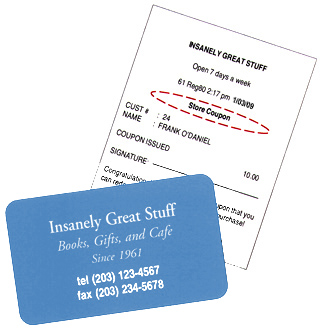

In general, customer loyalty programs tend to be one of two basic types:
• Cumulative programs, which extend rewards whenever a defined ‘threshold’ is reached, such as ‘receive a 20% discount for every $100 purchased’; or
• Immediate programs, in which the customer receives benefits with every purchase, such as 5% off every purchase.
‘Immediate’ programs are easier to manage because there’s no need to verify the customer’s purchase history in case of disputes.
WordStock enables a store to offer different loyalty programs simultaneously, each of which can have its own incentives. For example, you can have programs for both a ‘Classics Reading Group’ program and a ‘Women’s Studies’ program.
However, only membership type can be used in a given transaction, so we recommend that programs be defined broadly, to minimize customers having to maintain several ‘memberships.’
- Most stores will want to have permanent cards for their customers so that customers don’t have to remember their membership number(s) and store staff doesn’t have to spend a lot of time locating customers in the system.
Cumulative
Programs
• A ‘Cumulative’ Loyalty Program has a ‘triggerpoint’ when the customer receives a benefit, such as a discount. Until the triggerpoint is achieved, the customer’s purchases accrue, e.g., ‘save $10 with every $100 worth of purchases.’
• Can be more difficult to manage than Immediate programs because customers may wish to verify that all of their purchase have been tracked if it seems to them that they’re due to receive the program’s benefit.
• Discounts can be either a fixed amount, such as ‘$1.00 off’ or a fixed percentage, such as ‘10%’. You can assign the loyalty benefit to all items sold, or restrict it to specific Products or Sections.
Immediate
Programs
• An ‘Immediate’ Loyalty Program doesn’t have a ‘trigger point’; instead, the customer receives benefits, such as a discount, immediately, with every purchase.
• Easier for the store to manage, and for customers to use, than Cumulative programs because tendering immediate benefits eliminates having to ‘prove’ that enough purchases have been made to reach a goal.
• You can define loyalty discounts to be either a fixed amount, such as ‘$1.00 off’ or a percentage, such as ‘10%’.
• You can assign the loyalty to all items sold, or restrict it to specific Products or Sections.
Note: If your loyalty program varies substantially from the two core programs described here, please contact WordStock Sales, 800-753-9673, to discuss custom programming as a possible option.
Setting
Up Customer Loyalty Programs
|
The section below lists the questions you need to address to set up your loyalty program; please contact WordStock Support, 800-444-7224, if you need assistance or have any questions. As noted, WordStock supports two types of Loyalty programs: CUMULATIVE programs, which extend rewards whenever a defined threshold’ is reached, such as ‘receive a 20% discount coupon for every $100 purchased’; and IMMEDIATE programs, in which customers receive benefits, such as discounts, with every purchase. If your Loyalty program contains elements other than described below, custom programming is available for an additional fee; please contact WordStock Support for information, 800-444-7224. |
1. What is the name of your loyalty program? ___________________________________________________
2. Is there an enrollment fee for your loyalty program?
Y ____ N ____ If Yes, what is the fee? $_________
3. Does membership expire, i.e., must customers purchase items within a certain time period before accrued credit expires?
Y ____ N ____ If Yes, what is the period of time? ____________If renewing a membership is part of your program, should there be a warning that a customer’s membership will expire? Y ____ N ____
If Yes, how close to the expiration date should the warning begin to appear? _________________
4. What Products and/or Sections apply towards earning a reward? _____________________________________
5. What Products and/or Sections if any, should NOT apply towards earning a reward when sold? _____________________________________
6. When a customer earns a reward, should it be delivered as part of the current sale or the next time they purchase something from your store?
Now ____ [skip #7 below and go to #8] Next time ____
7. Choose a method of delivering rewards to customers:
Gift Certificate ___ Credit Slip ___ Coupon ___
8. Is your reward a specific dollar amount, based on a % of purchases or a specific item, such as a free t-shirt?
Dollar Amt ____ % of Sale____ Item_________________
9. There’s room on the gift certificate/credit slip/coupon for a message, such as “You’ve earned 20% off your next purchase!” Please write the message you want to print [40 character max]:
_________________________________________________
FOR CUMULATIVE PROGRAMS ONLY
10. Does a customer earn a reward based on an accrued dollar amount spent? Y ____ N ____ If Yes, what amount $_______
• Or is it based on the number of items?
Y ____ N ____ If Yes, what is the number? _____
11. Should overages carry over to the next reward cycle? For example, if your reward is triggered at $100, and a customer purchases $120, should the extra $20 be rolled over and included in the next reward cycle?
Y ____ N ____
| WordStock Sales: 800-753-9673 | HOME | Overview | Data Files | Point-of-Sale | Ordering | |
| Receiving | Reports | Special Orders | Mail Orders | Customers | ||
| Loyalty Programs | Loyalty Cards | Connectivity | Hardware | Site Preparation | ||
| PDF Documents | BUY SUPPLIES | Privacy | Store Profile | Contact Us | ||
|
Copyright © WordStock, Inc. WordStock® is a registered trademark of WordStock, Inc. Other trademarks are property of their respective owners. | ||||||